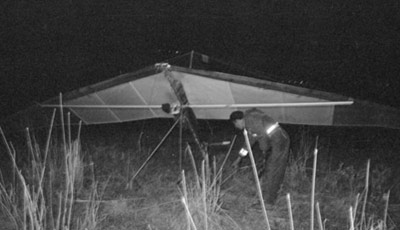Learn about the history of the Palestinian struggle for freedom, equality and justice by exploring major events in the history of their oppression on this day of the year.
25 November
 DARING ATTACK ON ISRAELI ARMY BASE
DARING ATTACK ON ISRAELI ARMY BASE
On this night in 1987, two Palestinian guerrillas used hang gliders to fly from South Lebanon to attack Israel military forces. Melod Najah entered Gibor Army Base and killed six Israeli soldiers, wounding eight others before he was killed. The attack boosted the morale of Palestinians under harsh Israeli military rule. Palestinian newspapers in the West Bank ran front page headlines but details were cut by the Israeli Military Censor. The writing "6:1" appeared on walls in Gaza.
هجوم جريء على قاعدة للجيش الإسرائيلي
25 نوفمبر
في تلك الليلة من عام 1987 ، استخدم مقاتلان فلسطينيان طائرات شراعية للطيران من جنوب لبنان لمهاجمة القوات العسكرية الإسرائيلية. دخل ميلود نجاح قاعدة جيبور العسكرية وقتل ستة جنود إسرائيليين وجرح ثمانية آخرين قبل مقتله. زاد الهجوم معنويات الفلسطينيين الخاضعين للحكم العسكري الإسرائيلي القاسي. وتصدرت الصحف الفلسطينية في الضفة الغربية عناوين الصفحات الأولى لكن الرقيب العسكري الإسرائيلي قطع التفاصيل. ظهرت الكتابة "6: 1" على الجدران في غزة.
The attack by Palestinian fighters on Gibor Amy Base provoked a response; Israeli soldiers carried out a massacre of four Palestinian workers on 8 December, which detonated the First Intifada.
According to the New York Times:
"The army command came under harsh criticism from Israeli newspapers for its failure to stop a Palestinian guerrilla on a motorized hang glider from penetrating the northern border and attacking a military base...
"According to army Chief of Staff Shomron, the Palestinian guerrilla, after landing his glider, shot two Israeli soldiers passing by in a car and then crossed a road to get to the Gibor base. The guard at the gate, instead of confronting the guerrilla when he approached, ran back into the camp as soon as the guerrilla threw a grenade at him..
"The Palestinian-owned Arabic newspapers published in the West Bank printed banner headlines about the guerrilla attack in colored ink. The military censor, however, prevented them from printing anything other than the barest details of the attack."
"In 1987, Palestinians under occupation also said ‘enough is enough’. It began with the killing of four unarmed labourers from the Jabalya refugee camp in Gaza, who were run over by Israeli soldiers in what Israel called an accident, and Palestinians eyewitnesses called a deliberate act of vengeance following the deaths of six Israeli soldiers at the hands of two Arab resistance fighters. This was the beginning of the First Intifada.
For six years, street battles were fought and won with stones. According to the United Nations, over 1,000 Palestinians were killed from 1987-1993.
The First Intifada has often been seen as a revolution of the mosques which, along with secular forces, gave the movement a direction. Islamic Jihad and the Muslim Brotherhood became important groups leading students and ordinary Palestinians, and in 1987, the creation of Hamas was announced.
Workers went on strikes, residents withdrew taxes, mothers started home-schooling their children as part of a social solidarity movement. In Beit Sahour, Palestinian residents defiantly threw away their mandatory, Israeli-issued ID cards as part of civil disobedience.
